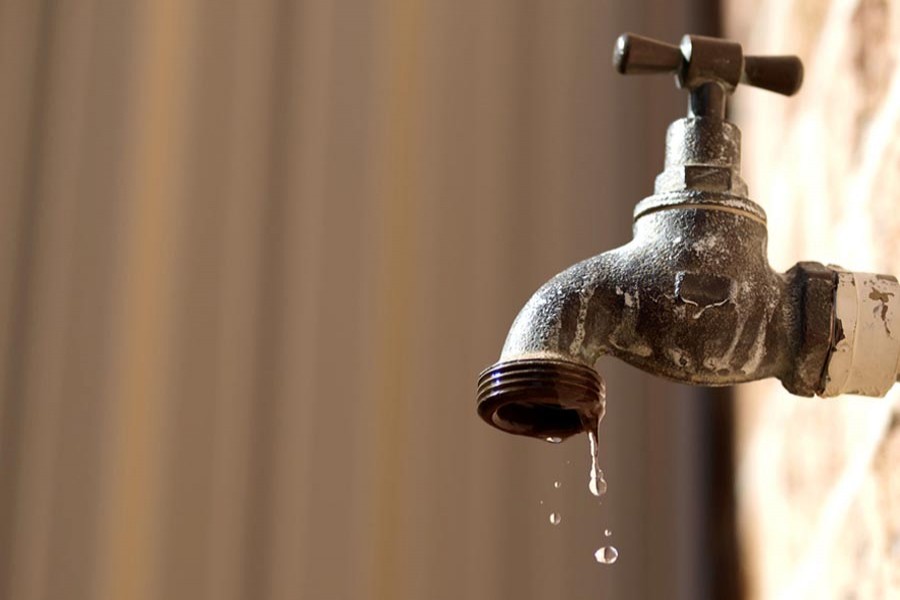The full Bangla season of summer has overtaken the country. The season begins from the month of Chaitra and continues till Jaishtha. Like in every year, the scourge of water crisis has already begun hitting Dhaka city this year, too. The age-old long queues of low-income people beside roadside taps for collecting water these days comprise the usual spectacle of Dhaka. This year is no exception. To add to the various forms of the crisis of clean water in Dhaka, scores of its neighbourhoods go without water supplied by Dhaka WASA (Water and Sewerage Authority) for days or weeks in a row. It was unthinkable 2/3 decades ago. In the early days, even in the 1960s, 'Kuas' (crude wells) were a common view in average households in the city. People would lift water manually from these wells with small buckets tied to long ropes or collect water from tube wells. Some upscale areas had, however, water coming from the treatment plants.
With households getting water from wells, and tube wells in some houses, Dhaka used to be considered a city self-sufficient in clean drinking water. The then water treatment plant had the capability to supply enough piped water to the residences. Moreover, during that time the Buriganga river was fully usable. The other three rivers surrounding Dhaka were sprightly with full flow of clean water. That Dhaka would fall on this plight in terms of water was beyond everybody's imagination back then.
Experts dealing with Dhaka's urban facilities believe the city's water woes began in the 1980s. In fact, the water scarcity of Dhaka began in earnest with the streaming of people into the capital after the country's independence in 1971. As decades wore on, it turned worse. With its population increasing exponentially, the city's water crisis became a formidable challenge to the fast-growing city's urban amenities infrastructure. Its highly distressing face became evident in the late 1990s. It has kept worsening since then. Newer areas began being hit by the scourge of water scarcity. Earlier, it was the older part of Dhaka that had been mostly plagued by the crisis. In the later decades, newer swathes of the capital were engulfed by it. In the second decade of the 21st century, the dry season, especially summer, is still a dreaded period. Dhaka WASA continues to offer pledges on freeing the capital of the water crisis by certain deadlines. But people in the crisis-hit areas continue to suffer.
As the water supply authorities have claimed lately, the city's water supply situation is "much better now". By 2021, the WASA tap water will become worth drinking, they add. But the reality is, the citizens in Dhaka have long been complaining against Dhaka WASA. It supplies water to 20 million people in the capital. The allegations include mostly the filthiness and stench in the piped WASA water. The water supply authorities have a capacity to pump up 2.45 billion litres of water. Moreover, nearly 1.7 billion litres of water are pumped through WASA's deep tube wells. Another 6.0 million litres are presently supplied from the Buriganga and the Shitalakhya. The flipside is, the treated river water is allegedly unusable due to faults in the supply lines in different areas. To speak tersely, the WASA water in vast segments of Dhaka is shunned by many people aware of the menace of water-borne diseases. Although the agency routinely asks people to drink its water after boiling it properly, few people attach importance to it. Many even do not bother to read the detailed and simply written newspaper advertisements.
Dependence on water purifying machines often ends in futility. The so-called bottled mineral water is being frequently proven risky. Another malady adds to the process of deterioration in Dhaka's alarming fall in its aquifer level. Excessive lifting of ground water by various establishments, including high-rise apartments, is also singled out as being responsible for Dhaka's present water crisis. In spite of the high promises on the part of the authorities to solve the city's water crisis, many old residents remain doubtful this will happen any time soon. As they have been observing, such pledges have been coming from Dhaka WASA since long. But no lasting and effective remedies have been seen being in place. Given the continued sloppy performance in supplying piped water, Dhaka WASA cannot afford to drag its feet in implementing its long-promised development programmes.


